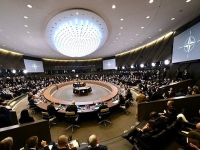Politics
NATO strengthens its defenses on its eastern border against the Russian threat
Plan will be defined in June
USPA NEWS -
At an extraordinary Summit in Brussels on March 24, 2022, Allied leaders agreed to reset NATO’s longer-term deterrence and defence posture across all domains, land, sea, air, cyber and space. This reflects the new security reality resulting from President Putin’s brutal and unprovoked war on Ukraine.
“At this dangerous time, transatlantic unity and solidarity are vital. Europe and North America are standing and will continue to stand strong together in NATO,” Secretary General Jens Stoltenberg said following the meeting. Allies agreed to increase support for Ukraine, including on cyber security, and chemical, biological, radiological, and nuclear attacks. They will continue to impose unprecedented costs on Russia to bring about an end to the war in Ukraine. They also approved four new multinational NATO battlegroups, in Bulgaria, Hungary, Romania, and Slovakia.
Discussions also addressed Belarus’ support for the invasion and China’s role in the crisis. “Beijing should use its significant influence on Russia, and promote an immediate, peaceful resolution,” Jens Stoltenberg added. And said: “President Zelensky addressed us with an impassioned message. Thanking NATO Allies for the significant support we are providing. And stressing the vital importance of even more military assistance.”
NATO leaders “agreed that we must and will provide further support to Ukraine. We will continue to impose unprecedented costs on Russia. And we will reinforce Allied deterrence and defence,” warned Stoltenberg. “Leaders approved our four new NATO battlegroups. In Bulgaria, Hungary, Romania, and Slovakia,” he announced.
These are in addition to the four already in the Baltic countries and Poland, said the Secretary General Stoltenberg. “So we have eight multinational NATO battlegroups now. From the Baltic Sea to the Black Sea. Across Europe, there are one hundred thousand US troops supporting NATO efforts. And European Allies and Canada have also stepped up. We have 40,000 forces under direct NATO command, mostly in the eastern part of the Alliance,” he added.
“Backed by major air and naval power. Including an unprecedented five carrier strike groups from the High North to the Mediterranean. On land, we will have substantially more forces in the eastern part of the Alliance, at higher readiness. With more prepositioned equipment and supplies. In the air, we will deploy more jets. And strengthen our integrated air and missile defence,” Stoltenberg explained.
At sea, “we will have carrier strike groups, submarines and significant numbers of combat ships on a persistent basis. We will also strengthen our cyber defences. And enhance our exercises, focusing on collective defence and interoperability. I expect we will decide on the details at our next Summit in Madrid in June,” he concluded.
Liability for this article lies with the author, who also holds the copyright. Editorial content from USPA may be quoted on other websites as long as the quote comprises no more than 5% of the entire text, is marked as such and the source is named (via hyperlink).






